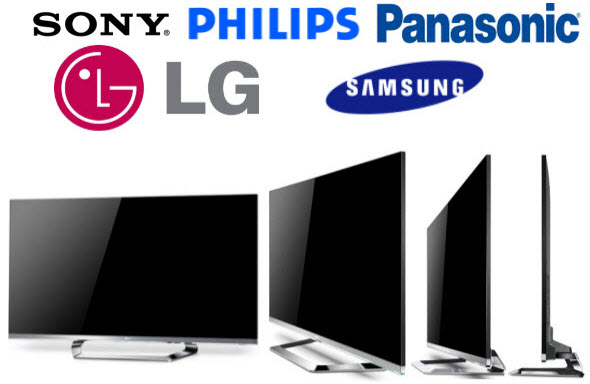Not so long ago televisions were uncomplicated, boxy contraptions that worked when they felt like it. Now you can choose from flat or curved, big or small, full HD or HD ready, plasma or LCD, 3D or 2D – the considerations read like an annual shopping list.

To make matters worse, we now have smart televisions. These clever goggle-boxes allow you to catch up on the latest iPlayer shows, watch YouTube videos, browse the web, stalk people on Facebook and download a virtual fireplace (we kid you not) among other things. Think of them as more like a computer, only you can still hook up your home surround sound system, DVD, Blu-ray player and games console as usual.
A question after the growing of Smart TV is: how to choose the right Smart TV and what factors I should consider while buying?
Now, this article will give you a detailed advice on how to choose the right Smart TV.
Part One: Know some famous brand Smart TV

Smart TVs are available from all the major manufacturers – including LG, Panasonic, Samsung, and Sony – but each has its own strengths and weaknesses.
Samsung Smart TV
Almost all of Samsung’s newer televisions are “smart”, starting with the 5500-series models and expanding upwards. You get Samsung’s “smart hub” homescreen, plus a good web browser and a wide range of apps, including all the major UK catch-up TV services.
For 2015, Samsung has announced a brand new smart-TV service powered by Tizen software, previously seen on smart watches and mobiles. This will have a completely redesigned user interface, backed up by a revamped smart-TV remote.
LG Smart TV
LG now offers two flavours of Smart TV – its legacy “Netcast” platform and its new generation of smart TVs powered by webOS technology, previously used on mobile devices. We’ve found that the legacy platform has a rather cluttered home dashboard. The pages are packed with icons and it’s all rather confusing to get around at first.
LG’s new webOS smart-TV service is better designed. You get a “launcher” bar at the bottom of the screen that allows you to quickly jump into things like the TV guide, apps or the web browser. You can customize the launcher with your favourite services by simply dragging and dropping them into the order you want.
Just like Samsung, LG offers two types of remote control – a standard version and a “magic” remote. The latter works a bit like a Nintendo Wiimote, with a moveable cursor on screen. It’s great with the smart-TV functions, but it’s only included free on the pricier TVs, otherwise you’ll have to buy it separately, while some models don’t support it at all.
LG has updated webOS for 2015, primarily to make it run faster and be easier to use.
Sony Smart TV
Sony offers a good range of apps, including Netflix, Amazon Video, BBC iPlayer and Demand 5, but the continued absence of ITV Player and 4oD remains an issue. However, you do get Sony’s own Video Unlimited service pre-loaded, offering films and other video content to watch. Plus, Sony is the only one of the brands featured here not to have advertising on its smart-TV service.
We often criticize Sony’s Smart TV service for being hard to use. Navigating the smart-TV features with Sony’s standard remote control can be a pain. Sony has an extra remote featuring a laptop-style trackpad, but poor navigation on the smart-TV platforms means it’s still not that easy to get around, and using the web browser is a source of frustration.
Sony has announced that all its 4K TVs and some new HD TVs will come with Android TV in 2015. Based on Google’s popular operating system, this smart-TV service features apps, games and other internet services presented in a colorful and accessible user interface.
Panasonic Smart TV
Panasonic’s smart-TV service was a bit of a late developer compared to LG and Samsung, but it’s now competitive with the other brands. Panasonic’s big feature is homescreens that you can personalize to your tastes with your favorite apps, shortcuts and even decoration.
Panasonic offers a free-to-download “Swipe & Share” app allowing you to share content such as videos and photos from a mobile device with your TV. Some Panasonic sets come with TV Anywhere, an app service that lets you remotely watch TV channels or stored PVR content on a smart phone or tablet, even while away on holiday.
From our recent testing, we’ve found Panasonic’s smart-TV service OK to use, although there’s definitely room for improvement. The navigation can be unintuitive at times, particularly if you’re using the standard remote rather than Panasonic’s smart version with a trackpad and voice control options.
Panasonic has announced that some of its 2015 TVs will come with a new smart-TV service powered by Firefox, the popular web browser. Firefox OS has a refreshed and customizable homescreen among its various features.
Part Two: Eight things to consider before you buy
Screen Size
The size of your display is critical to the impact of your Smart TV and movie-watching experience. Your goal is to get the biggest screen you can and create an optimal, cinema-like viewing window, but without overwhelming your room’s aesthetics or sitting so close that individual pixels that make up the image become visible and distracting. Here are some tips and tricks in amazon to insure you can “go big” while avoiding unpleasant surprises when you unpack your new set. TV buying guide – screen size.
Resolution
Screen resolution is a key specification of any TV, be it LED, Plasma, or OLED. It determines the TV’s ability to show fine detail, and it’s determined by the number of picture elements, or “pixels”, used to create the image. More pixels mean more detail and smoother, more natural rendering of the edges of onscreen objects. Most high definition displays today use a grid with 1,920 horizontal pixels running across the width of the screen and 1,080 vertical rows of pixels running top to bottom. You’ll see this listed in the specifications as “1920 x 1080”. These displays are also referred to as having “1080p” or “Full HD” resolution. New 4K Ultra HD TV displays quadruple the pixel count to 8 million in a grid that’s 3840 x 2160. The larger number of smaller, tighter pixels for a given screen size allows viewers to sit much closer to the screen compared with a 1080p set of the same size, or enjoy a much larger screen from the same viewing distance without fear of detecting the pixels.
Backlight Technology
Today’s TV industry spouts enough jargon to make a new HDTV shopper run for the hills, arms flailing. But don’t worry, we’ve got you covered. In this section, we’ll discuss the different ways today’s TVs make their pictures and the strengths and weaknesses of each.
LED: The most widely available and popular HDTVs today are liquid crystal displays that use an LED backlight, often just referred to as an LED HDTV. LED sets are lightweight, energy efficient, thin in profile, and have the ability to make very bright images—a plus for watching in a sun-drenched room.
Plasma: Plasma televisions are known for delivering excellent contrast while getting bright enough for all but the very brightest rooms, though you’ll see fewer of them in the market these days.
OLED: OLED, or organic light-emitting diode, represents the cutting edge of display technology. Unlike other display technologies, OLED HDTVs have the ability to reproduce true black along with bright, punchy highlights, essentially delivering infinite contrast and striking image quality. OLED displays can be made very thin, and they’re lightweight and energy efficient.
Refresh Rate
The content you view on your Smart TV as video is really a series of still images flashing in rapid succession. The images are flashed so quickly that the illusion of motion is created, and the speed at which the images are flashed on screen every second is referred to as the refresh rate. A faster refresh rate ensures fluid motion, great for watching content with lots of action such as sports or playing video games. Read on to learn more about how refresh rates work and what your options are when shopping for a new Smart TV.
Smart TV Features
In general, the features of the Smart TV will be increased and strengthened as the price moves higher. You should consider the following main features when buying smart TV: supported apps ( Read here to see what apps do you get on different Smart TVs ), smart recommendation, web browsing capability, files streaming capability.
Color
Unless you’re preference is a black-and-white tube TV, the quality of a TVs color is a key consideration when shopping. While finding an objective measure of color is difficult, it helps to understand how TVs create colors, and why color range is an important factor in the quality of your viewing experience. In this guide we’ll cover both the technology behind TV color, and the steps you can take to ensure you get the most accurate color out of your TV.
Help & Support
When you purchase a Smart TV, it’s nice to know the manufacturer has your back. In case you have a question about your TV or encounter a warranty issue, it’s important to have customer support options like live chat, email or toll-free phone help. The industry standard for TV warranty is one year.
Budget
No matter how you like a Smart TV after comparing the above factors, don’t forget to see how much you have in your pocket. Only got a few pennies to spare? Panic not, as smart TV prices have dropped quite considerably, especially if you shop around at your nearest supermarket or Richer Sounds. January is usually a good time to buy a TV and so is September and October. Black Friday and Cyber Monday can also yield good results if you strike quickly. Be wary of Christmas as prices can be raised. If you can put up with last year’s model, big savings can be had. Better still, keep an eye on the clearance section of your local TV retailers to see if something pops up. But before you shell out, however, do some prior research as to what you need.
Part Three: Conclusion
In the end, based on those guidelines, it is up to you to choose the best solution for your needs. If you know what you are looking for and keep in mind the important points discussed above, it should not be difficult anymore for you to decide which Smart TV suits you best. Additionally, you can compare some of the the best Smart TVs of 2015.
Part Four: How to Stream Videos to Smart TVs?
You may have problems when you want to play Blu-ray and iTunes videos in Smart TV.
As we all know most of the Blu-ray discs are digital protected by the publisher, you have to crack the protection from Blu-ray disc first then stream in TVs.
And iTunes videos are DRM protected, you also should convert them to common video formats supported by your Smart TV.
If you are Youtube fan, learn how to watch YouTube videos on TVs in multiple ways.